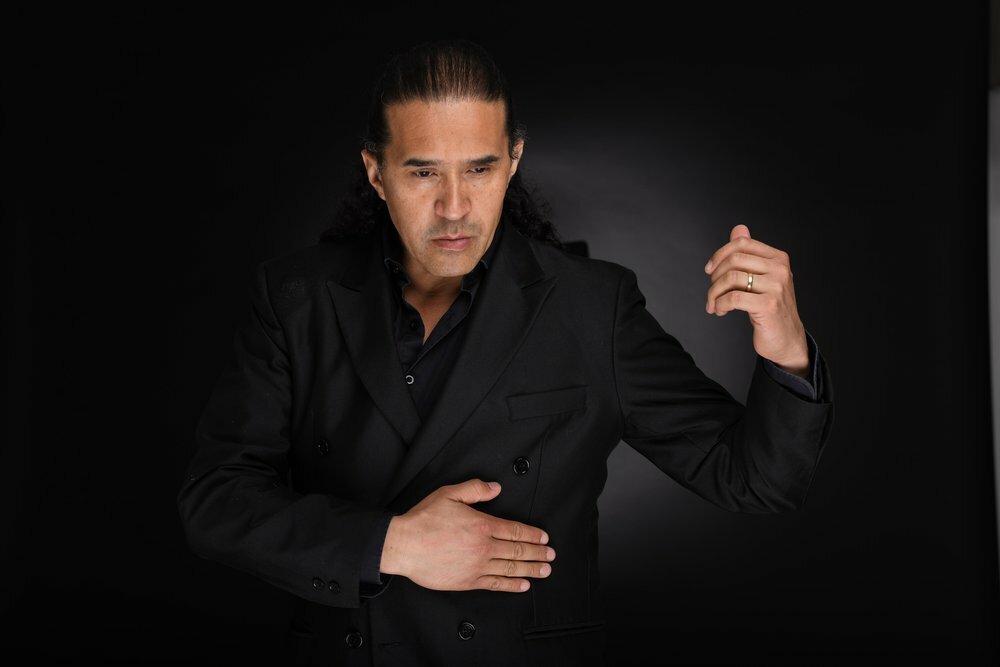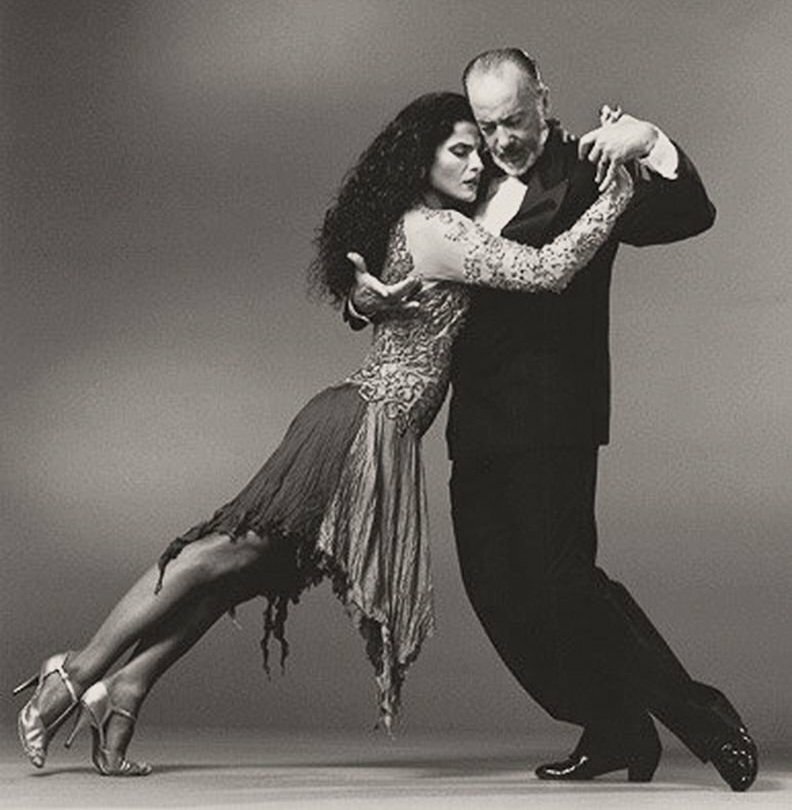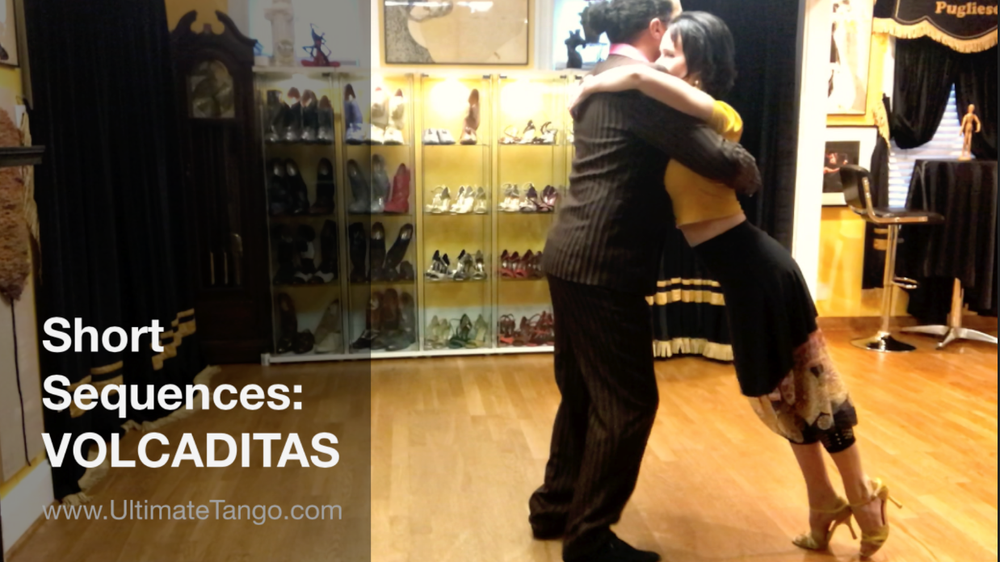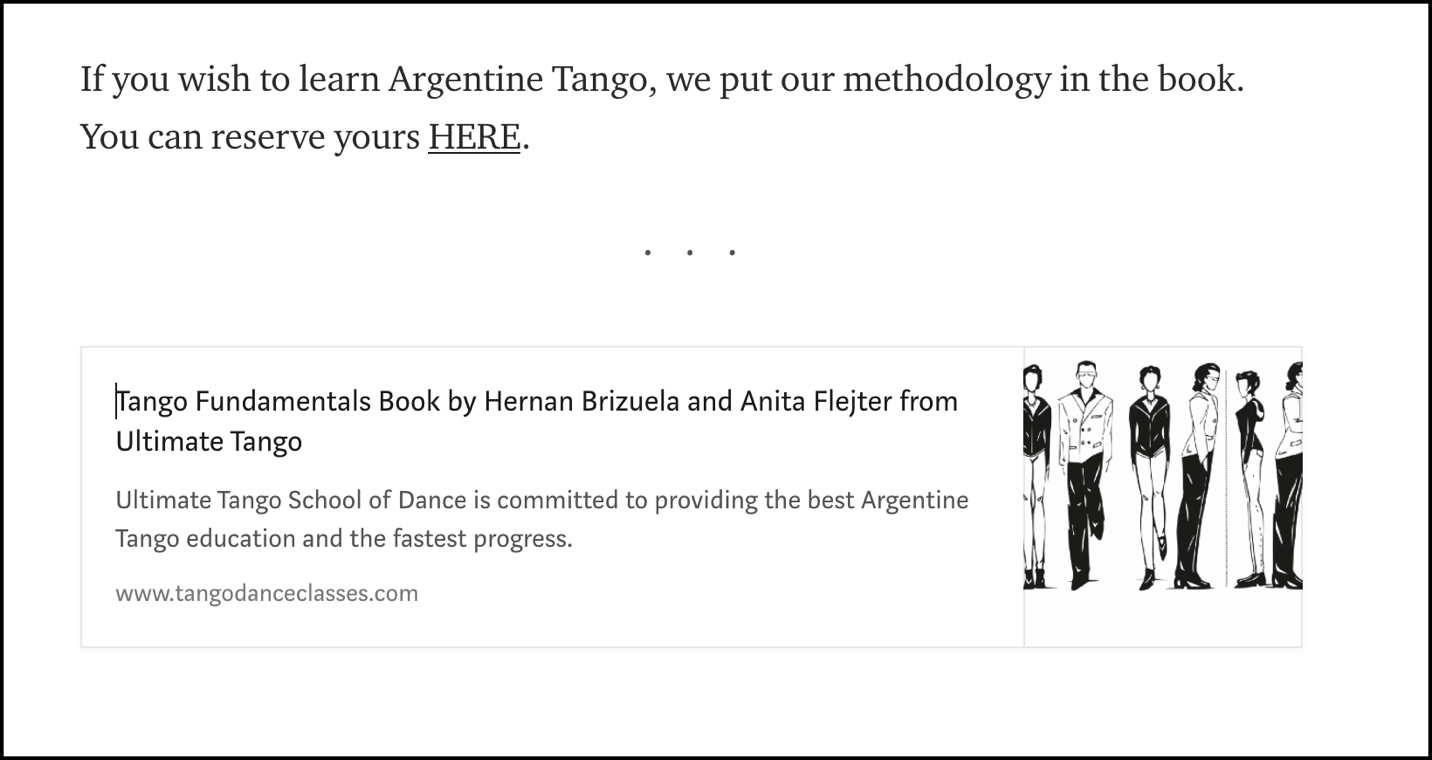Those aspiring to master Argentine tango today are likely to find tons of resources about the dance’s steps and figures.
However, unlike some dances, tango remains “unstandardized.” This means there are many arbitrary rules not only in etiquette but also in the dance itself.
In principle, this is advantageous to everyone who wants to learn about tango as there is no “right way” to do it. At the same time, it can be somewhat disadvantageous as there may be a bit of confusion as to the terminology concerning styles, steps, and figures. This can make it a challenge for learners who are better at retaining information through written definitions.

Volcaditas - Short Sequences. On-demand course: https://courses.ultimatetango.com/courses/volcaditas-short-sequences
That said, there is often some overlap in terms of definition for the apilado and the volcada. To many,
the volcada might seem like a step often placed in contrast with its supposed opposite, the colgada.
On the other hand,
the apilado is often understood similarly with the concept of tango milonguero, or the milonguero style of dancing.
A quick search online would yield results in which the volcada and apilado are also used interchangeably.
But are the apilado and the volcada really the same?

The Shared Axis
To understand the apilado and the volcada, one must first realize the common factor between these two terms: off-axis or shared axis dancing.
According to MasTango,
off-axis positions are those wherein the “center of balance moves outside of one’s body.”
Conversely, the same post defines
on-axis positions as a “body position where [the] legs are approximately perpendicular to the floor.”
An apile is considered an off-axis style of dancing, which may use positions like the volcada.
Further to off-axis positions, the lean or tilt of the body is taken into consideration. Since dancing entirely off-axis is not possible alone, an off-axis position presupposes a shared axis between both dancers. This is where a lean or tilt takes place, whether toward or away from one’s partner. With this shared axis, one or both dancers can continue moving despite being off their individual axis. In some cases, the shared axis can be temporary (volcada) or can be maintained throughout the dance (apilado).
Let’s try this approach,
the apilado is a style of dance wherein both partners are leaning towards each other in a shared axis position.
Meanwhile,
the volcada is when the follower leans toward the leader while the leader maintains their own individual axis, creating a temporary shared axis.
In some cases, the volcada can be maintained throughout the entire dance. However, this can be tiring as one partner, primarily the follower, is constantly in an off-axis position.

Carlos Gavito - Marcela Duran
The Apilado
Though it is the norm that both partners should ideally maintain their own axis and balance while dancing tango, some still prefer to dance with the apilado style.
One of the most prominent tango dancers known for dancing with the apilado style is Carlos Gavito.
In this YouTube video, Gavito and his partner Marcela Duran demonstrate the lean or shared axis being maintained almost entirely throughout their performance.
It is interesting to note, however, that some tango dancers consider Gavito’s way of dancing the apilado style as a commercialized version, or one that’s purposefully exaggerated for show. According to a post from Tango Mentor, showing off is one of the most common mistakes made when dancing in apilado. The author of the blog explains:
“Dancing like Gavito is cool only for the stage. Please, don’t imagine that this is how one should dance apilado: sharing the axis in social dancing is very subtle and dancers never use it 100% of the time.”
“So, when you enter the ronda and embrace your partner, lean and invite her/him to lean on you in a very subtle way. You never transfer all your weight, imagining some drama you’ve seen on YouTube. It is so subtle that sometimes people watching you can’t tell if you are leaning or dancing on your own axis.
“Don’t use apilado as a banner telling others ‘I dance differently.’ Apilado is not something to be seen — it is a tool that can make your connection deeper; something that can make you feel your partner better and make him/her feel that you trust and can be trusted.”
Further to these sentiments about apilado, some have pointed out that milongueros in Buenos Aires rarely use the apilado style when dancing, or at least not that which Carlos Gavito employs.
This can be another source of confusion for other tango dancers who may have heard that the apilado style and tango milonguero style are the same, as the terms are often used interchangeably. How can a style not often used by milongueros themselves be understood as the same as one called the tango milonguero style?
A post from Tango Voice explains how this came to be:
“Tango Milonguero is a classificatory label for a style of tango dancing that is characterized by a maintained embrace, a forward-leaning posture, compact movements, and improvisation focused on the interpretation of the music.
“Tango Apilado is a label applied to a style of tango dancing where couples lean forward against each other, with contact maintained at the level of the chest. In this type of dancing the partners are described as projecting their weight forward to share an axis, rather than maintaining their own axis.

Susana Miller
“Tango Apilado has sometimes been used as a synonym for Tango Milonguero, including by Susana Miller, who invented the terminology ‘Tango (estilo) milonguero’.
Milonguero Pedro Rusconi (‘Tete’) has used the term ‘apilado’ to describe his own manner of dancing. [...]
Interview with Nestor La Vitola (childhood friend of Pedro “Tete” Rusconi and many other milongueros) - https://www.tangoexchange.com/interview-with-nestor-la-vitola/
“Given that dancers in the milongas of Buenos Aires who maintain the embrace throughout the dance, and specifically milongueros who serve as role models for social dancing, maintain their own axes while dancing in the shared embrace. This style of dancing, commonly known as Tango Milonguero, does not include the shared axis emanating from an extended forward lean characteristic of a style of dancing that has been labeled as Tango Apilado.
Tango Apilado is therefore primarily an exaggeration in posture that is sometimes used as part of tango stage performances, i.e., not in the context of the milonga.”
How then is the apilado related to the volcada? According to a post from Very Tango Store,
“The apilado is a prerequisite for the volcada.”
This can mean that the style of dancing that often uses the volcada is the apilado.
The Volcada
Dancing the apilado can look rather beautiful on stage, though there is some degree of difficulty in maintaining a shared axis throughout the dance. There are also some postural considerations that make this style and the technique it requires unsuited for beginners. The stability of one’s connection and embrace with their partner is also a factor. Thus, for those interested in using the apilado style, one may perhaps begin with the concept of the volcada.
Often mistaken for a specific step,
the volcada is a fairly new concept wherein the follower dances in an off-axis position by leaning on the leader.
In contrast,
the colgada is another off-axis position wherein the lean is going away from each other.
Though performing a volcada can employ the same exaggeration as seen in Carlos Gavito’s style of dancing, it is often recommended for the volcada to be much more subtle. This YouTube video from Howcast serves as a good starting point when trying to understand and practice the concept of the volcada.
In the same video, tango instructors Diego Blanco and Ana Padron remind viewers that
while the volcada can be done with a big step, it is better to start off small so as not to put undue strain on the follower.
To exaggerate the lean may “kill the chemistry.” Moreover, the follower should not collapse their back while doing the lean but instead maintain a straight spine. The lean is likened to doing a plank position or a slightly small push-up, wherein the flexion happens in the ankles.
To successfully perform a volcada, the embrace between partners must also be intact so that the follower can “spill” their weight onto the leader — “to spill” being the Spanish word for volcada.
For the leaders, they must maintain their own axis and balance. It is also important for leaders to remember not to initiate with their arms but to move their torso as one piece. This enables one to perform stable footwork when changing direction.
What’s the Fuss About the Apilado and the Volcada?
Perhaps one point of contention concerning both apilados and volcadas is that they take up more space on the dance floor.
This makes these concepts rather unsuited for milongas, which are often crowded with dancers in small or rather tight spaces. Since many tango dancers learn tango to participate in milongas, few have a positive opinion on the apilado and volcada, especially the former. Considering the technique, balance, posture, embrace, stability, and practice required to perform the apilado style or a volcada successfully, this sentiment is understandable.
But should one veer away from trying out the apilado style or a volcada altogether?
Not necessarily. Perhaps, when one is a beginner, trying out these concepts may seem too ambitious. However,
what makes tango such a fascinating dance is that one may always find some measure of discovery during one’s learning journey.
One may eventually discover that dancing with the apilado style, which requires a deep close embrace, can be more fulfilling than dancing with just a “standard” close embrace or an open embrace. Similarly, one may also eventually discover that the volcada is a beautiful addition to one’s repertoire of movements.
All things considered, it boils down to a matter of personal preference. Of course, one should not forget that while one may be personally comfortable with the apilado style or a volcada, the comfort level of one’s partner should always be respected. Since these are viewed as intermediate or advanced concepts, not everyone may want to perform them, especially during crowded milongas.
Further, because the apilado style and volcada involve a lean, one’s safety on the dance floor should also be taken into account. Accidents can happen, and it is important for every dancer to be aware of their spatial boundaries. This would keep them from ruining their own experience and that of others while dancing.

Understanding Is Key
As mentioned, there is no one “right way” to dance Argentine tango (though some may argue about individual or collective proficiency).
As such, understanding the concepts involving tango is paramount to efficient execution. Naturally, diligent practice is required, especially for intermediate or advanced concepts such as the apilado style and volcada. Though there may be some confusion or even a fuss concerning their appropriateness in a milonga or on stage, it remains a good thing indeed to be aware of what they are so that one can enrich their knowledge of tango.Understanding Is Key
As mentioned, there is no one “right way” to dance Argentine tango (though some may argue about individual or collective proficiency).
As such, understanding the concepts involving tango is paramount to efficient execution. Naturally, diligent practice is required, especially for intermediate or advanced concepts such as the apilado style and volcada. Though there may be some confusion or even a fuss concerning their appropriateness in a milonga or on stage, it remains a good thing indeed to be aware of what they are so that one can enrich their knowledge of tango.
If you wish to learn Argentine Tango, we put our methodology in the book. You can reserve yours HERE.


